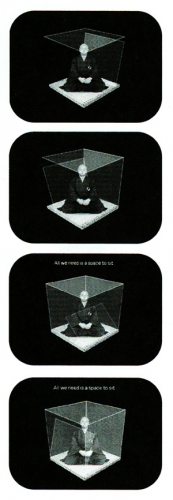
When I first encountered the dharma, some two decades ago, it arrived at my door looking achy and lethargic and smelling of beer. In the aftermath of a loud and fragrant freshman dorm party, I had rescued my next-door neighbor from a night spent face-down on the damp floor where he’d slid to a stop and fallen asleep.
The following day, Jonathan dropped by to offer me as thanks a copy of Shunryu Suzuki’s Zen Mind, Beginner’s Mind, which he had been introduced to by an older brother. Considering the circumstances, it struck me as an odd gift, and he surrendered it with little ceremony and less explanation (he made sure to point out the page with the fly, and left it at that). But I remember thinking sometime later that, almost by accident, I’d come into possession of something profound and catalytic, and that even though monks and robes and incense were missing from the whole transaction, what the gesture pointed toward was genuine and stocked with real possibility.
This was, to say the least, a novel sensation. I had grown up in a factory town full of Christian sports enthusiasts, and if there were Buddhists of any sort around, they cannily escaped notice. Nor was there a local bookstore—not even a chain outlet, let alone an independent seller trafficking in religious subversion. And anyway, after a childhood of catechism at the hands of the disaffected priests and short-tempered nuns who staffed out parish, I was as wary of those who claimed spiritual expertise as I was untrusting of my own ability to recognize it. I was largely inclined to let sleeping gods lie.
So the seeds of Suzuki’s wisdom fell not lightly over some rich and spacious field but into a smallish pot of poorly fertilized soil. That may explain why, even after a number of years of sitting meditation according to the instructions he outlines, I came to believe that Buddhism meant Zen Buddhism—or, more precisely, SotoZen Buddhism—and that the whole business was somehow neatly self-contained. I was confident that my handful of books, my buckwheat hull zafu and booster pillow, and my ferocious, solitary practice were quire enough. And that, in turn, probably explains why, on my first retreat (with a local Soto community, of course), when I asked the woman leading rhe group whether I needed to find a teacher and she answered unhesitatingly, “Yes, if only because it’s a proof of commitment,” the panicky thought arose: great—what do I do now?
What I committed to, instead, was my new computer, a primitive PC clone that I somehow coaxed into connecting over a phone line to other computers and other computer users. I learned co swap technical tips and small software programs and, eventually, digital messages about the things that interested me. I also learned that there were people out there who, like me, were interested both in computers and in Buddhism, and thar some of them (notably, a Dr. T. Marrhew Ciolek in Australia and the members of a self-styled “cybersangha” known as Tiger Team) were building libraries of Buddhist texrs online. Over my 2,400-baud modem, this larger world came trickling in like a draft around a poorly framed door. Despire my best efforts, community—and the commitment that community sooner or later entails—was finding me.

I now spend most of my working days online, and I know that the Internet can provide (to those wrestling with all manner of things, including the dharma) teachers and texts and community in abundance. It’s easy to imagine how different my early sense of Buddhism might have been if that initial encounter had occurred fifteen years later, after the World Wide Web had sprung to life—how much harder it would have been for me to try to squeeze the dharma down to the size of a single school or a single book. There would have been all too much to explore, and it would have been all too handily accessible.
Virtually every school of Buddhism is represented online these days. There are vast treasuries of sutras and commentaries and transcribed talks, and numerous projects devoted to adding more every day. There are galleries of thangkas and mandalas; forums that invite discussion on subjects ranging from posture to politics; monks who will answer e-mailed queries about the subtle and not-so-subtle points of practice; schedules for retreat centers around the globe; and dharma talks in streaming audio and video, available at any hour. There are, in other words, myriad ways in which anyone hoping to cultivate an awakened mind can nurture the impulse.
I don’t mean to say that the ocean of information flowing through the Internet, however extensive it may be, could have rinsed away my ignorance. And I don’t mean to overlook the obvious option I’ve had of sitting with other teachers and sanghas, of more often confronting the dharma in its occasionally messy but reliably galvanic human form. Indeed, there are times when, drifting from site to site in pursuit of one clarifying piece of information or another, I begin to feel a bit like a voyeur. I miss the sharp, corrective reply that makes me think: great—what do I do now?
But I would argue that there is something in the Net’s immense reach, in its interconnectedness and efficiency as a conduit, that can provide an immediate sense of the dharma’s encompassing vastness and some insight into its rich variety. What’s more, a Web page exists, truly, only where and when a surfer views it—and this shapeless contingency perhaps even hints at what’s meant by emptiness. Looked at from a certain angle, its form becomes as suggestive as its content. And there are lessons in that.
A few years ago, when my mother was still alive but beginning to succumb to cancer, I gave her a book that described a simple meditation technique, in the hope that it would help her through what lay inevitably ahead. Many weeks later, I asked her what she made of it. Was she able to follow her breath? Was it getting any easier to remain still? Well, she told me, sometimes she would sit in her chair and hold the book in her lap, and it would give her a kind of comfort.
However one encounters them—on retreat, on a page, or online—the teachings of the dharma can be like that: items to clutch for comfort. But then the moment comes when someone—in a retreat center or in a dorm room or even in an e-mail message—asks you to look inside what you’re holding. More often than not, you’ll be astounded by what you find.
The abundance of dharma resources available online can be overwhelming.
If you’re looking for information about a specific school, teacher, or practice, the most efficient approach may be to use such search engines as Google and MetaCrawler.
There are also, of course, many sites that serve as wonderful starting points. Any of the following will amply reward the curious surfer:
Thank you for subscribing to Tricycle! As a nonprofit, we depend on readers like you to keep Buddhist teachings and practices widely available.